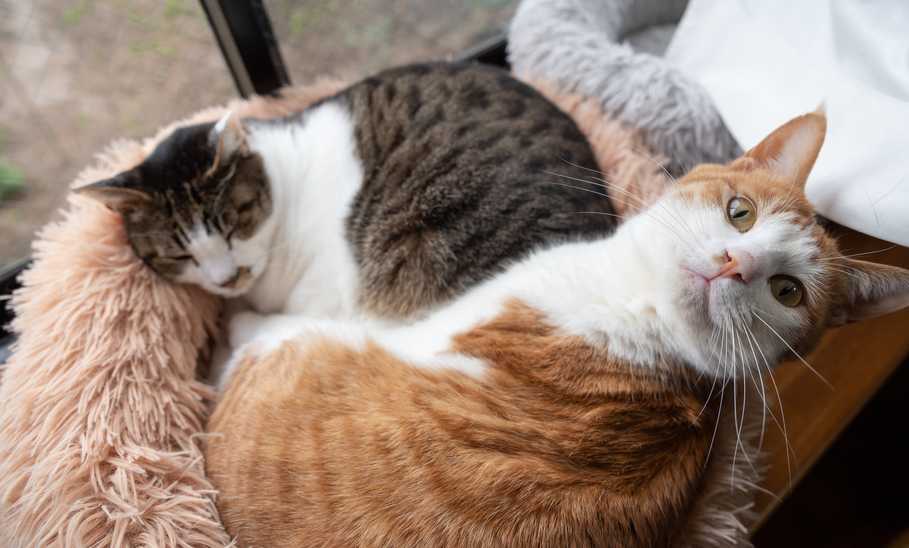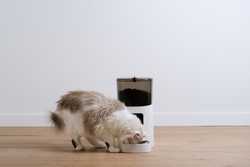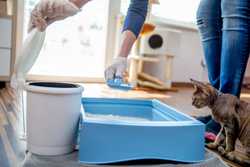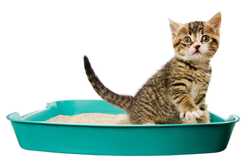How Much Should a Cat Weigh For Optimal Health?

Our evaluations and opinions are not influenced by our advertising relationships, but we may earn a commission from our partners’ links. This content is created by TIME Stamped, under TIME’s direction and produced in accordance with TIME’s editorial guidelines and overseen by TIME’s editorial staff. Learn more about it.
At veterinary hospitals, weight is a common topic of conversation. Being overweight can affect other body systems and can predispose an animal to a host of other medical issues such as diabetes and orthopedic problems. Obesity affects up to 63% of adult cats in developed countries, but as with many things in life, weight is not a one size fits all discussion. Some breeds are naturally larger than others. I wouldn’t expect, or want, an adult female Tonkinese to weigh the same as an adult male Maine Coon, or vice versa. Thankfully, there are clear indicators that tell you a cat is at a proper weight, or over/under. Read on to learn what these are and more.
The ideal weight range for a standard size adult Domestic Shorthair (DSH) cat is 8 to 10 pounds. However, this is just a starting point and your cat may weigh more, or possibly less, and still be at a healthy weight.
The problem with the average weight is it won’t apply to all cats. Some breeds are naturally more petite and some are naturally larger. With certain breeds, there can also be a difference between males and females. For example, a male Norwegian Forest Cat weighs 12 to 16 pounds while females are usually 9 to 12 pounds.
A cat’s ideal weight is determined by examining them and assigning them a Body Condition Score (BCS) using a standardized chart that is scaled from one to nine or one to five. Which chart a veterinarian uses is personal preference. On both charts, a score of one is severely underweight/emaciated (20% or more underweight) and nine (or five) is obese (30% or more overweight). To accurately arrive at a score, the exam involves assessing what a cat’s body looks and feels like when viewing them from the top and side while they’re standing.
When your cat is examined by a veterinarian, their weight will also be recorded in the medical record. Healthy adult cats should be weighed at least once a year. Healthy senior cats should be weighed at least twice a year. Pets with medical issues which affect weight may need to be weighed more frequently and your veterinarian will let you know how often that should be.
Yes it does. Some breeds are naturally larger than others. Your average Domestic Shorthair cat’s ideal weight is going to be less than bigger breeds like the Main Coon, Siberian, and Norwegian Forest Cat.
Age often affects weight because as cats get older, they can become less active due to things like arthritis or weight gain because of a slowed metabolism after being spayed or neutered.
Weight can also be affected by intestinal parasites, viral infections, or nutrition (e.g., too much or not enough food). Older cats might start to lose weight due to health conditions such as kidney disease, hyperthyroidism, or cancer. They can also gain weight if they’re more sedentary, such as from having arthritis-related pain. Arthritic cats usually don’t have obvious signs of pain, so it often goes undiagnosed.
Overweight means a cat weighs 10 to 20% more than their ideal body weight. Obese is when a cat’s weight is greater than 20% of their ideal. For better understanding, The Association for Pet Obesity Prevention compares pet weight to people and states “a Domestic Shorthair cat that weighs 15 pounds is equal to a 218 pound, 5’ 4” female or a 254 pound, 5’ 9” male.”
Feeding an appropriate amount of good quality cat food, portioning meals instead of free-feeding, monitoring body weight, and encouraging play behavior for exercise are all important to help keep your cat at a healthy weight. If you’re unsure how much to feed your cat, talk with your veterinarian. They can calculate your pet’s daily caloric needs and help you determine what that means in terms of how much dry and/or wet cat food to feed.
To help catch issues early that might cause weight loss or weight gain, an annual wellness exam and lab work for cats under the age of 11 years, and biannual exams and lab work for cats 11 and older, is recommended. Wellness exams can also uncover sources of hidden pain (e.g., dental disease) and other undiagnosed medical issues.
Some conditions like arthritis can cause a cat to gain weight because they become sedentary due to pain. Arthritic cats usually don’t have obvious signs of pain and people often assume their cat is simply “slowing down” due to age.
Other medical issues can cause weight loss, such as hyperthyroidism or kidney disease. Some cats can also have multiple medical issues at once, so keeping up with veterinary appointments is important.
If your cat is overweight or obese, the first thing you want to do is schedule an appointment with your veterinarian. A cat’s physiology is different from dogs, and weight loss in cats needs to be medically supervised. For cats, a sudden reduction in calories can be dangerous because it can cause a liver condition called hepatic lipidosis.
Hepatic lipidosis occurs when fat gets mobilized (such as from an abrupt decrease in food intake), and that fat deposits in the liver, causing the cat to become quite sick. This can also occur in cats who aren’t feeling well for any reason and suddenly eat less or stop eating, and it can happen in as little as two to four days.
Your veterinarian will develop a gradual weight loss plan for your cat with a target weight in mind, and they may recommend a change in food. This could be a switch from dry to wet food for more protein and fewer carbohydrates, or possibly even switch to a prescription weight loss food. While on a diet, it’s important to make sure your cat isn’t sneaking snacks from other pets’ bowls. Since a cat on a diet shouldn’t be free-fed, consider getting an automatic cat feeder for convenience.
Depending on your cat’s general health and abilities, your veterinarian may also have you encourage exercise, such as with interactive cat toys and providing a cat tree that encourages climbing and possibly playing if it has a string ball attached to it. It’s important to remember that weight loss takes time. It’s reasonable to expect a cat to lose half a pound to one pound a month. At that rate, it might take six months or even a year to safely lose excess weight.
This depends on why a cat is underweight. The treatment for a young cat who is underweight due to being a stray with intestinal parasites and inadequate nutrition will be vastly different compared to an older cat with hyperthyroidism and kidney disease.
As with overweight cats, the first thing to do is schedule an exam with your veterinarian. You don’t want to assume that all that’s needed is more food because being underweight can be caused by a variety of ailments ranging from (but not limited to) internal parasites, viral infections, cancer, kidney disease, and hyperthyroidism. Cats can get progressively more sick, and more challenging to successfully treat, if they’re abruptly losing weight, it’s best to not delay diagnosis and get professional help early on.
At your cat’s appointment, the staff will get a history and the doctor will perform an exam. They may recommend tests like blood work, urinalysis, fecal parasite tests, and possibly even imaging like radiographs (x-rays) or ultrasound. This might happen in stages, with some tests being recommended after baseline blood results are obtained.
There are two body condition score charts that are used. One is a one to five scale and the other is one to nine. I prefer the one to nine because it’s more exact. A cat is evaluated while they are standing on all fours, or all three for the tripods!
| Body Condition Score | Physical Traits |
|---|---|
1 Emaciated | Very visible ribs, spine, and hip bones. Very narrow waist. Very little muscle. No palpable fat on ribs. (On the 1 to 5 scale, this would be a 1 as well.) |
2 Very thin | Easily visible ribs, spine, and hip bones. Very narrow waist. Minimal muscle. No palpable fat on ribs. |
3 Underweight | Visible ribs. Defined waist. (On the 1 to 5 scale, this would be a 2 out of 5.) |
4 Lean but not problematic | Ribs aren’t visible, but are easy to feel. Defined waist. |
5 Ideal | Well-proportioned body. Ribs aren’t visible but are easy to feel. Defined waist. (On the 1 to 5 scale, this would be a 3 out of 5.) |
6 Overweight | Ribs aren’t visible but can be felt. Waist isn’t clearly defined when the cat is standing and viewed from above. |
7 Mild obesity | Difficult to feel the ribs. Barely visible waist. Belly fat is visible. (On the 1 to 5 scale, this would be a 4.) |
8 Moderate obesity | Cannot feel the ribs. Waist isn’t visible at all. Belly is distended with fat. |
9 Severe obesity | Cannot feel the ribs. No waist. Significant amount of fat on the body. (On the 1 to 5 scale, this would be a 5.) |
The information presented here is created by TIME Stamped and overseen by TIME editorial staff. To learn more, see our About Us page.



